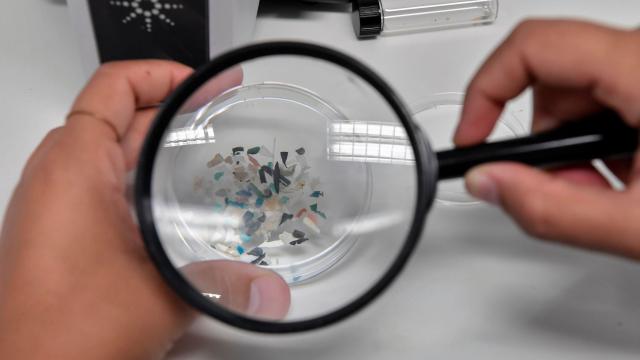Plastic garbage floating on the ocean may draw the most outrage, but it accounts for just 1 per cent of the 9.1 million tonnes of plastic that get into the world’s oceans every year. The rest of it ends up in the deep ocean, and new research has revealed where it’s accumulating.
Microplastic pollution is piling up on the ocean floor more than ever before, according to a study published in Science on Thursday. Most of that microplastic is coming not from broken down plastic soda bottles or shopping bags but textiles and clothing made of synthetic materials like polyester.Â
All that microplastic isn’t getting dispersed evenly. Deep sea currents are acting as conveyor belts, carrying tiny plastic particles across the seafloor”similar to garbage patches that currents create on the ocean’s surface. The researchers collected samples specifically from the Tyrrhenian Sea, an area of the Mediterranean off the western coast of Italy. They chose the area because of the currents that move through as well as the fact that the seafloor there is similar to many other parts of the ocean.
They collected samples from the seafloor and analysed them back on land. Every single sample had microplastic in it. Samples from apparent hotspots contained an estimated 1.9 million pieces of microplastic per just one square metre of seafloor. That’s the highest amount of microplastic ever found on the seafloor.
They also conducting modelling that shows why this is such a huge issue beyond the study area. Those same conveyor belts transporting plastic also transport nutrients to the same hotspots. So in essence, pollution is likely accumulating in areas that are also biodiversity hotspots, including breeding zones for fish, sponges, sea cucumbers, corals and other creatures.
Scientists have much more to learn about how microplastic pollution is impacting those creatures, but there have already been some concerning discoveries. One recent study, for instance, found that exposure to microplastic can disrupt hermit crabs’ cognitive functioning, making it harder for them to find shells to live in.
Microplastic pollution can also make its way all the way up the food chain. Small creatures like salps and plankton often consume the tiny particles, and many marine animals such as fish and crabs consume those little guys. Humans, in turn, often consume fish and crabs, meaning the microplastic can find its way into our bodies. There’s evidence that eating microplastics can expose us to hormone-disrupting chemicals.
“The results highlight the need for policy interventions to limit the future flow of plastics into natural environments and minimise impacts on ocean ecosystems,” Mike Clare of the National Oceanography Centre, who was a co-lead author on the research, said in a statement.
There’s a lot policymakers could do to curb this microplastic crisis. We could design clothes with the goal of emitting fewer microfibers, which more than half of clothes sold worldwide today contain. We could create and employ better filtration systems for facilities that treat waste and water to catch microplastics before they enter our waterways. And best of all, we could stop producing so much plastic in the first place, including polyester, acrylic, and nylon clothing. Beyond the ocean pollution thing, plastics are made of fossil fuels, which we should be keeping in the ground anyway.
